|
|
|
Sort Order |
|
|
|
Items / Page
|
|
|
|
|
|
|
| Srl | Item |
| 1 |
ID:
184181


|
|
|
|
|
| Summary/Abstract |
In its magazine, Sunnat-e Khola, Tahrik-e Taliban Pakistan (TTP) called upon women to rise because the ‘Time of Martyrdom has come’. This research addresses questions surrounding how women are framed in jihadi rhetoric and what roles they play within these frames. Using a mixed-methods approach, we analysed sixty-eight jihadi magazines by Islamic State (ISIS), TTP, Al Qaeda, and Taliban, generating 3,417 codes which were further sorted into relevant contextual categories. These data were analysed through the lenses of social movement framing theory, which highlight the nuances and fine-grain differences among the aforementioned jihadi extremist groups in how women are depicted and how women’s agency within these groups is constructed. A significant finding of this paper is that Al Qaeda and ISIS often show opposite trends in how they depict women within diagnostic, prognostic, and motivational framings. Furthermore, while the TTP has a higher proclivity to follow similar patterns to ISIS, the Taliban shares more similarities with Al Qaeda than any other group. For example, both ISIS and TTP are more likely than the Taliban and Al Qaeda to encourage women to do hijra and join jihad.
|
|
|
|
|
|
|
|
|
|
|
|
|
|
|
|
| 2 |
ID:
184183
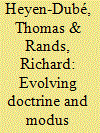

|
|
|
|
|
| Summary/Abstract |
A violent extremist group poses a significant threat to parts of Cabo Delgado province. Since its first major attack in October 2017, it has perpetuated a conflict to the detriment of sections of the population and government, as well as disrupting economic development. Little is known about the group and there is a considerable amount of confusion in policymaking and academic circles about the nature of the violent extremists (VE) and their relationship to the wider global Salafi-Jihadi community. By analysing the theological underpinnings of VE and their action in Cabo Delgado (CD), we bring clarity to this debate to enable international actors and policymakers in Mozambique navigate the complexities of the situation. From this analysis we conclude the following: VE are not Salafi-Jihadis as they do not share their ideological and theological understanding of the world. It is more accurate to present VE as challengers to the established order. Their struggle is best understood as a challenge to authorities to secure increased political and religious representation, and socio-economic benefits in CD.
|
|
|
|
|
|
|
|
|
|
|
|
|
|
|
|
| 3 |
ID:
184180
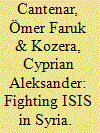

|
|
|
|
|
| Summary/Abstract |
This paper analyses the Operation Euphrates Shield (OES) al-Bab battle and presents the lessons learned. OES started with a mixed force of Free Syrian Army, Turkish special forces and armoured units. During the operation, the aims and the force structure gradually changed, yet not the command structure. When OES aimed to capture al-Bab, ISIS employed conventional active defence strategy. The OES commander’s insistence on employing special forces increased own casualties and al-Bab was seized only after resorting to a conventional urban attack. OES presents tactical and operational lessons for the militaries on structure and execution of operations against an irregular adversary employing conventional means.
|
|
|
|
|
|
|
|
|
|
|
|
|
|
|
|
| 4 |
ID:
184182
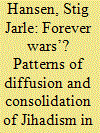

|
|
|
|
|
| Summary/Abstract |
The article will discuss the patterns that jihadism has followed when spreading throughout sub-Saharan Africa, addressing the major scholarly debates but also to bring forward the elements that various African cases seemingly have in common. The discussions over African Jihadism has seen several great debates, over the ungoverned space theory, a dichotomous discussion of the local and the global as opposing explanatory models, and a discussion of the role of ‘greed’ and economic incentives. The article argues that these discussions need to be transcended, and that dichotomous discussions fail to see more complex patterns of interaction between various factors, and the complexity of social relations that at times depend on the different contexts we study. Understanding how global networks can harness local conflicts to gain support is key to understanding African jihadist groups, and how those harnessing strategies can be limited. The article also suggests that there is an emerging consensus over several of the factors that do occur in sub-Saharan African jihadism and present the implications of these findings for the ongoing conflict in Mozambique and Tanzania.
|
|
|
|
|
|
|
|
|
|
|
|
|
|
|
|
| 5 |
ID:
184186
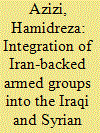

|
|
|
|
|
| Summary/Abstract |
Since 2018, an increasing number of Iran-backed armed groups have started to be integrated into the Syrian and Iraqi official armed forces. The integration of armed groups allows Tehran to enjoy a multi-layered, longer-term, and potentially less expensive influence in Iraq and Syria. Besides, underlying ideological and ideational ties between the armed groups and Iran continue to affect their strategic choices. Meanwhile, and in order to preserve its ability to directly impact the developments, Tehran continues to support an array of smaller militias outside the state structures. This indicates a shifting pattern in Iran’s regional network, from relying predominantly on non-state actors to enjoying a more complex set of non-state and semi-state allies. The consolidation of this model could have considerable implications for Iraq and Syria: 1- Dual loyalties in the Iraqi and Syrian states will make it difficult to form an inclusive government and promote national unity; 2- Anti-American and anti-Israeli ideological elements in the Iraqi and Syrian armed forces’ structure could prevent establishing better ties with the US or Israel; 3- The concern of Iran’s regional rivals over the expansion of Tehran’s influence in Iraq and Syria turns the two countries into a theater for regional confrontations.
|
|
|
|
|
|
|
|
|
|
|
|
|
|
|
|
| 6 |
ID:
184179


|
|
|
|
|
| Summary/Abstract |
Based on conflict data, interviews and media monitoring, this study of Myanmar’s non-inclusive ceasefires develops a four-step argument about the effect of ceasefires in complex conflict systems. First, non-state armed groups rarely co-ordinate their actions strategically. This makes it easy for governments to obtain ceasefires with some groups while fighting others. Second, when ceasefires ensure armed groups’ survival, they mostly hold. Third, non-inclusive ceasefires do not reduce a country’s overall level of violence, since fighting tends to escalate with excluded groups. On this basis we conclude that non-inclusive ceasefires do not present a viable alternative to an inclusive peace process.
|
|
|
|
|
|
|
|
|
|
|
|
|
|
|
|
| 7 |
ID:
184184
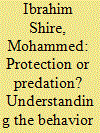

|
|
|
|
|
| Summary/Abstract |
During civil wars, some communities raise self-defense militias to protect themselves from insurgent predation, but these militias can end up mutating into predatory organizations. The extant literature has focused chiefly on the predatory propensity of state-created self-defense militias and has mostly overlooked why some community-created self-defense militias segue into predatory organizations while others eschew predation altogether. This study explains this phenomenon, drawing on in-depth interviews with active members of two community-created self-defense militias (Ahlu Sunna Waljama’a and Macawiisley) in Somalia. In doing so, two sequential mechanisms (sponsorship and mobility) that determine the propensity of predatory behavior are introduced. Self-defense militias that conduct offensive operations engage in predatory behavior, irrespective of whether they are sponsored locally or have external patrons. Externally sponsored self-defense militias that engage in offensive operations attract opportunistic recruits and become motivated by material benefits, while community-sponsored self-defense militias that conduct offensive operations instrumentalize their position to settle old scores against rival communities. By contrast, self-defense militias that restrict their operations to defensive activities typically recruit dedicated homegrown members, and are regulated by community-managed accountability mechanisms that prevent predatory and abusive behavior. This community control remains crucial for defensive self-defense militias, who must balance external patrons’ strategic aims with their local objectives.
|
|
|
|
|
|
|
|
|
|
|
|
|
|
|
|
| 8 |
ID:
184185


|
|
|
|
|
| Summary/Abstract |
The psychiatric cost of Britain’s post-war counter-insurgency campaigns have gone largely un-investigated. Focusing on the Malayan Emergency, this article will show that counter-insurgency operations were sufficiently intense to produce what were conceptualised as cases of mild psychoneurosis. These conditions were managed using convalescence and simple psychotherapy. Managing these conditions in this way risked leaving more serious conditions untreated and meant recorded cases of psychoneurosis were kept artificially low. That the stresses of the counter-insurgency in Malaya were reproduced elsewhere suggests there was a wider psychiatric cost of Britain’s post-war period of decolonisation.
|
|
|
|
|
|
|
|
|
|
|
|
|
|
|
|
|
|
|
|
|